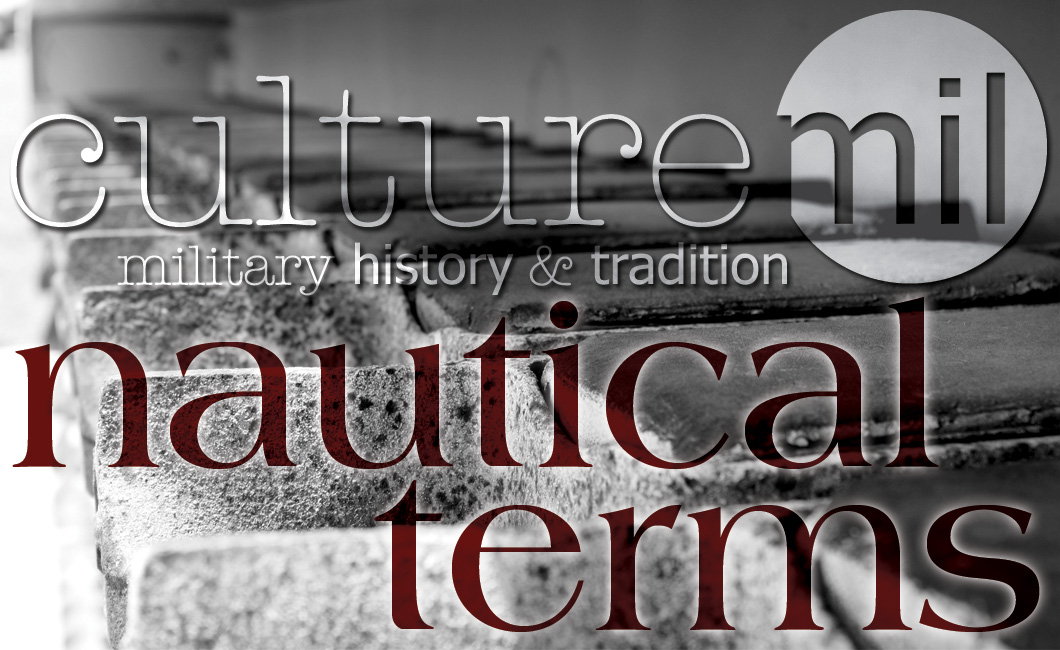- Noon to 4:00 p.m. – Afternoon watch
- 4:00 p.m. to 6:00 p.m. – First dogwatch
- 6:00 p.m. to 8:00 p.m. – Second dogwatch
- 8:00 p.m. to midnight – 1st night watch
- Midnight to 4:00 a.m. – Middle watch or mid watch
- 4:00 to 8:00 a.m. – Morning watch
- 8:00 a.m. to noon – Forenoon watch
- http://www.history.navy.mil/browse-by-topic/heritage/terminology/nautical-terms-and-phrases-their-meaning-and-origin.html
- http://internet.savannah.chatham.k12.ga.us/schools/jhs/clubs/NJROTC/Shared%20Documents/Academics/Nautical%20Terms%20and%20History.pdf
Written by Jenifer Chrisman on September 19, 2016.
The Navy has a long and rich history spanning more than 200 years. Throughout its years of service to the country the Navy has developed a number of nautical terms which have become part of their customs and traditions. Each has its own unique origin, including some based purely on superstition. And it is no surprise that some terms have found their way into daily use.
Before the Mast: Literally, the position of the crew whose living quarters on board were in the forecastle (the section of a ship forward of the foremast). The term is also used more generally to describe seamen as compared with officers, in phrases such as “he sailed before the mast.”
Binnacle List: A ship’s sick-list. A binnacle was the stand on which the ship’s compass was mounted. In the eighteenth century and probably before, a list was given to the officer or mate of the watch containing the names of men unable to report for duty. The list was kept at the binnacle.
Boot Camp: During the Spanish-American War Sailors wore leggings called boots, which came to mean a Navy (or Marine) recruit. These recruits trained in “boot” camps.
Bravo Zulu (BZ): This is a naval signal, conveyed by flaghoist or voice radio, meaning “well done;” it also has passed into the spoken and written vocabulary. It can be combined with the “negative” signal, spoken or written NEGAT, to say “NEGAT Bravo Zulu,” or “not well done.”
Brass Monkey: It has often been claimed that the “brass monkey” was a holder or storage rack in which cannon balls (or shot) were stacked on a ship. Supposedly when the “monkey” with its stack of cannon balls became cold, the contraction of iron cannon balls led to the balls falling through or off of the “monkey.” This explanation appears to be a legend of the sea without historical justification. In actuality, ready service shot was kept on the gun or spar decks in shot racks (also known as shot garlands in the Royal Navy) which consisted of longitudinal wooden planks with holes bored into them, into which round shot (cannon balls) were inserted for ready use by the gun crew.
Brightwork: Brightwork originally referred to polished metal objects, and bright woodwork to wood which was kept scraped and scrubbed, especially topside. Bright it should be and work it is.
Bull Ensign: The Bull Ensign is the senior ensign of a Navy command (ship, squadron, or shore activity). In addition to normal duties, the Bull Ensign assumes various additional responsibilities such as teaching less-experienced ensigns about life at sea, planning and coordinating wardroom social activities, making sure the officers’ mess runs smoothly and serving as an officer (such as treasurer) for Navy-related social organizations. The Bull Ensign is responsible for preventing junior ensigns in his command from embarrassing themselves and the Navy. Though the position often has little formal authority, the Bull Ensign serves as the focal point for the unit’s expression of spirit and pride. A Bull Ensign will often be recognized by his uniform’s oversized gold ensign collar device engraved with the word “Bull.”
Charlie Noble: Charlie Noble is an “it,” not a “he.” A British merchant service captain, Charles Noble, is said to be responsible for the origin, about 1850, of this nickname for the galley smokestack. It seems that Captain Noble, discovering that the stack of his ship’s galley was made of copper, ordered that it be kept bright. The ship’s crew then started referring to the stack as the “Charley Noble.”
Clean Bill of Health: This widely used term has its origins in the document issued to a ship showing that the port it sailed from suffered from no epidemic or infection at the time of departure.
Coxswain: A coxswain or cockswain was at first the swain (boy servant) in charge of the small cock or cockboat that was kept aboard for the ship’s captain and which was used to row him to and from the ship. The term has been in use in England dating back to at least 1463. With the passing of time the coxswain became the helmsman of any boat, regardless of size.
Dogwatch: A dogwatch at sea is the period between 4 and 6 p.m, the first dogwatch, or the period between 6 and 8 p.m., the second dog watch. The watches aboard ships are:
The dogwatches are only two hours each so the same Sailors aren’t always on duty at the same time each afternoon. Some experts say dogwatch is a corruption of dodge watch and others associate dogwatch with the fitful sleep of Sailors called dog sleep, because it is a stressful watch. But no one really knows the origin of this term, which was in use at least back to 1700.
Down the Hatch: Here’s a drinking expression that seems to have its origins in sea freight, where cargoes are lowered into the hatch. First used by seamen, it has only been traced back to the turn of the century.
Duffle: A name given to a Sailor’s personal effects. Also spelled duffel, it referred to his principal clothing as well as to the seabag in which he carried and stowed it. The term comes from the Flemish town of Duffel near Antwerp, and denotes a rough woolen cloth made there.
Dungarees: The modern Sailor’s work clothes. The term is not modern, however, but dates to the 18th century and comes from the Hindi word dungri, for a type of Indian cotton cloth.
Fathom: Although a fathom is now a nautical unit of length equal to six feet, it was once defined by an act of Parliament as “the length of a man’s arms around the object of his affections.” The word derives from the Old English Faethm, which means “embracing arms.”
Flogging: A form of old punishment where a Sailor was beat with a rod or whip for some infraction. Also means to criticize harshly.
Flying Dutchman: One superstition has it that any mariner who sees the ghost ship called the Flying Dutchman will die within the day. The tale of the Flying Dutchman, trying to round the Cape of Good Hope against strong winds and never succeeding, then trying to make Cape Horn and failing there too, has been the most famous of maritime ghost stories for more 300 years. The cursed spectral ship sailing back and forth on its endless voyage, its ancient white-haired crew crying for help while hauling at her sail, inspired Samuel Taylor Coleridge to write his classic “The Rime of the Ancient Mariner,” to name but one famous literary work. The real Flying Dutchman is supposed to have set sail in 1660.
Fouled Anchor: The fouled (rope- or chain-entwined) anchor so prevalent in our Navy’s designs and insignia is a symbol at least 500 years old that has it origins in the British traditions adopted by our naval service. The fouled anchor was adopted as the official seal of Lord High Admiral Charles Lord Howard of Effingham during the late 1500s. A variation of the seal had been in use by the Lord High Admiral of Scotland about a century earlier. The anchor (both with and without the entwined rope) is a traditional heraldic device used in ancient British coats of arms. As a heraldic device, it is a stylized representation used merely for its decorative effect.
Frocking: Regarding the practice of frocking, there are various instances in Navy Regulations, at least as early as 1802, of personnel assuming the uniform of the next higher rank. They did not necessarily receive higher pay, but were appointed by proper authority to assume the duties and responsibilities of that rank prior to actual promotion. These appointments were sometimes temporary, as when it was necessary to rapidly swell the ranks during war time, especially in the Civil War. Other instances concerned a commander’s need to fill an unforseen vacancy for which there was no one of equal rank. In this case, a junior who was qualified for promotion would assume the uniform and duties pending approval by the Navy Department.
Gedunk (also Geedunk or Gedonk): Gedunk refers to ice cream, candy, potato chips and other snack foods, as well as to the place on a ship where these items are sold.
Head: The use of the term “head” to refer to a ship’s toilet dates to at least as early as 1708, when Woodes Rogers (English privateer and Governor of the Bahamas) used the word in his book, “A Cruising Voyage Around the World.” Another early usage is in Tobias Smollett’s novel of travel and adventure, “Roderick Random,” published in 1748. “Head” in a nautical sense referring to the bow or fore part of a ship dates to 1485. The ship’s toilet was typically placed at the head of the ship near the base of the bowsprit, where splashing water served to naturally clean the toilet area. Other maritime uses of the term refer to the top or forward part, such as the mast (top of the mast/masthead), and the top edge of a sail, as well as the compass direction in which the ship is pointing.
Holystone: Holystone, a soft sandstone, was often used to scrub the decks of ships, where Sailors had to kneel as if in prayer to accomplish the task. Holystone was often called so because it is full of holes.
Keel Hauling: A naval punishment on board ships said to have originated with the Dutch but adopted by other navies during the 15th and 16th centuries. A rope was rigged from yardarm to yardarm, passing under the bottom of the ship, and the unfortunate delinquent secured to it, sometimes with lead or iron weights attached to his legs. He was hoisted up to one yardarm and then dropped suddenly into the sea, hauled underneath the ship, and hoisted up to the opposite yardarm, the punishment being repeated after he had had time to recover his breath. While he was under water, a “great gun” was fired, “which is done as well to astonish him so much the more with the thunder of the shot, as to give warning until all others of the fleet to look out and be wary by his harms” (from Nathaniel Boteler, A Dialogicall Discourse, 1634). The U.S. Navy never practiced keel hauling.
Mayday: The distress call for voice radio, used for vessels and people in serious trouble at sea. The term was made official by an international telecommunications conference in 1948. It is an anglicizing of the French “m’aidez” (help me).
Piping: Boatswains have been in charge of the deck force since the days of sail. Setting sails, heaving lines and hoisting anchors required coordinated team effort and boatswains used whistle signals to order the coordinated actions. When visitors were hoisted aboard or over the side, the pipe was used to order “Hoist Away” or “Avast heaving.” In time, piping became a naval honor on shore as well.
Port and Starboard: Port and starboard are shipboard terms for left and right, respectively. Confusing those two could cause a ship wreck. In Old England, the starboard was the steering paddle or rudder, and ships were always steered from the right side on the back of the vessel. Larboard referred to the left side, the side on which the ship was loaded. So how did larboard become port? Shouted over the noise of the wind and the waves, larboard and starboard sounded too much alike. The word port means the opening in the “left” side of the ship from which cargo was unloaded. Sailors eventually started using the term to refer to that side of the ship. Use of the term “port” was officially adopted by the U.S. Navy by General Order, 18 February, 1846.
Radar: An acronym standing for “Radio Anamoly Detecting And Ranging.”
Scuba: An acronym standing for “Self-Contained Underwater Breathing Apparatus.”
Scuttlebutt: The cask of drinking water on ships was called a scuttlebutt and since Sailors exchanged gossip when they gathered at the scuttlebutt for a drink of water, scuttlebutt became U.S. Navy slang for gossip or rumors. A butt was a wooden cask which held water or other liquids; to scuttle is to drill a hole, as for tapping a cask.
Shows His True Colors: Early warships often carried flags from many nations on board in order to elude or deceive the enemy. The rules of civilized warfare called for all ships to hoist their true national ensigns before firing a shot. Someone who finally “shows his true colors” is acting like a man-of-war which hailed another ship flying one flag, but then hoisted their own when they got in firing range.
Side Boys: Tending the side with side boys, as we know it in modern practice, originated long time ago. It was customary in the days of sail to hold conferences on the flagships both when at sea and in open roadstead. Also, officers were invited to dinner on other ships while at sea, weather permitting. Sometimes the sea was such that visitors were hoisted aboard in boatswain’s chairs. Members of the crew did the hoisting, and it is from the aid they rendered in tending the side that the custom originated of having a certain number of men always in attendance. Some have reported the higher the rank, the heavier the individual; therefore, more side boys.
Smoking Lamp: The exact date and origin of the smoking lamp has been lost. However, it probably came into use during the 16th century when seamen began smoking on board vessels. The smoking lamp was a safety measure. It was devised mainly to keep the fire hazard away from highly combustible woodwork and gunpowder. Most navies established regulations restricting smoking to certain areas. Usually, the lamp was located in the forecastle or the area directly surrounding the galley indicting that smoking was permitted in this area. Even after the invention of matches in the 1830s, the lamp was an item of convenience to the smoker. When particularly hazardous operations or work required that smoking be curtailed, the unlighted lamp relayed the message. “The smoking lamp is lighted” or “the smoking lamp is out’ were the expressions indicating that smoking was permitted or forbidden. The smoking lamp has survived only as a figure of speech. When the officer of the deck says “the smoking lamp is out” before drills, refueling or taking ammunition, it is the Navy’s way of saying “cease smoking.”
Sonar: An acronym for “Sound Navigation And Ranging,” is underwater echo-ranging equipment, originally for detecting submarines by small warships.
Striking the Flag: Striking the ensign was and is the universally recognized indication of surrender.
Suit: A nautical term, dating from at least the early 1600s, meaning the outfit of sails used by a ship. The term was revived after World War II when a Navy ship’s complement of electronics could be referred to as its electronics suit, and its total armament might be called its weapons suit. The word is sometimes incorrectly spelled “suite.”
Tar or Jack Tar: Tar, a slang term for a Sailor, has been in use since at least 1676. The term “Jack tar” was used by the 1780s. Early Sailors wore overalls and broad-brimmed hats made of tar-impregnated fabric called tarpaulin cloth. The hats, and the Sailors who wore them, were called tarpaulins, which may have been shortened to tars.
Toe the Line: The space between each pair of deck planks in a wooden ship was filled with a packing material called “oakum” and then sealed with a mixture of pitch and tar. The result, from afar, was a series of parallel lines a half-foot or so apart, running the length of the deck. Once a week, as a rule, usually on Sunday, a warship’s crew was ordered to fall in at quarters – that is, each group of men into which the crew was divided would line up in formation in a given area of the deck. To ensure a neat alignment of each row, the Sailors were directed to stand with their toes just touching a particular seam. Another use for these seams was punitive. The youngsters in a ship, be they ship’s boys or student officers, might be required to stand with their toes just touching a designated seam for a length of time as punishment for some minor infraction of discipline, such as talking or fidgeting at the wrong time. A tough captain might require the miscreant to stand there, not talking to anyone, in fair weather or foul, for hours at a time. Hopefully, he would learn it was easier and more pleasant to conduct himself in the required manner rather than suffer the punishment. From these two uses of deck seams comes our cautionary word to obstreperous youngsters to “toe the line.”
Sources:



